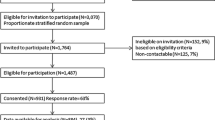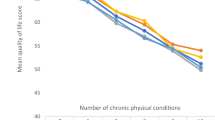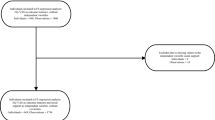Abstract
Summary
Participants with physical limitation and high degree of pain had poor mental and physical health-related quality of life. In addition, the more support and exercise that the participants had, the more likely theywere to report better health-related quality of life.
Introduction
Osteoporosis is a public health threat worldwide. The aim of this study is to examine the effects of individual demographics, disease characteristics, and social support on health-related quality of life (HrQoL) of adults with osteoporosis. Most psychosocial studies focused on the relationships but not the specific construct of social support on HrQoL.
Methods
In a correlational design, face-to-face, structured interviews were employed to collect information. Study questionnaires included a demographic sheet, the modified Social Support Inventory, and the Short-Form 36 scales on a convenience sample of 161 individuals recruited from four outpatient centers. Using the structural equation modeling approach, all relationships among factors, mediators, and HrQoL were analyzed.
Results
The mean duration of osteoporosis was longer than 5 years. Participants who exercised more than three times per week had greater HrQoL than individuals who exercised less frequently. Participants with physical limitation and high degree of pain had poor mental and physical HrQoL. The more support that the participants perceived, the more likely they were to report better HrQoL. The best fitted structural equation modeling (SEM) model included individual demographics and physical function, and social support as significant predictors on HrQoL, with informational support and physical function acting as mediators in those relationships. Moreover, this structural model explained 35, 42, and 40 % of the variance on activity of daily living (ADL), physical, and mental health-related quality of life.
Conclusions
The more informational support that individuals have, the more likely they were to report better HrQoL. Individuals with osteoporosis who have lower pain and more exercise are considered having better HrQoL. Further longitudinal research will help clarify the direction of these relationships.


Similar content being viewed by others
References
Harvey N, Dennison E, Cooper C (2010) Osteoporosis: impact on health and economics. Nat Rev Urol 6(2):99–105
Wang Y, Tao Y, Hyman ME, Li J, Chen Y (2009) Osteoporosis in China. Osteoporosis Int 20(10):1651–1662
Looker AC, Melton LJ, Harris TB, Borrud LG, Shepherd JA (2010) Prevalence and trends in low femur bone density among older US adults: NHANES 2005–2006 compared with NHANES III. J Bone Miner Res 25(1):64–71
Guillemin F, Martinez L, Calvert M, Cooper C, Ganiats T, Gitlin M, Horne R, Marciniak A, Pfeilschifter J, Shepherd S, Tosteson A, Wade S, Macarios D, Freemantle N (2013) Fear of falling, fracture history, and comorbidities are associated with health-related quality of life among European and US women with osteoporosis in a large international study. Osteoporos Int 24(12):3001–3010
Looker AC (2013) Femur neck bone mineral density and fracture risk by age, sex, and race or Hispanic origin in older US adults from NHANES III. Arch Osteoporos 8(1–2):141
Wilson S, Sharp CA, Davie MW (2012) Health-related quality of life in patients with osteoporosis in the absence of vertebral fracture: a systematic review. Osteoporos Int 23(12):2749–2768
Krum SA, Brown M (2008) Unraveling estrogen action in osteoporosis. Cell Cycle 7(10):1348–1352
Roux C, Wyman A, Hooven FH, Gehlbach SH, Adachi JD, Chapurlat RD, Compston JE, Cooper C, Diez-Perez A, Greenspan SL, Lacroix AZ, Netelenbos JC, Pfeilschifter J, Rossini M, Saag KG, Sambrook PN, Silverman S, Siris ES, Watts NB, Boonen S (2012) Burden of non-hip, non-vertebral fractures on quality of life in postmenopausal women: the Global Longitudinal study of Osteoporosis in Women (GLOW). Osteoporos Int 23(12):2863–2871
Petronijevic M, Petronijevic N, Ivkovic M, Stefanovic D, Radonjic N, Glisic B, Ristic G, Damjanovic A, Paunovic V (2008) Low bone mineral density and high bone metabolism turnover in premenopausal women with unipolar depression. Bone 42(3):582–590
Chan HL, Liu CY, Chau YL, Chang CM (2011) Prevalence and association of suicide ideation among Taiwanese elderly—a population-based cross-sectional study. Chang Gung Med J 34(2):197–204
Wu Q, Magnus JH, Liu J, Bencaz AF, Hentz JG (2009) Depression and low bone mineral density: a meta-analysis of epidemiologic studies. Osteoporosis Int 20(8):1309–1320
de Oliveira FN, Arthuso M, da Silva R, Pedro AO, Neto AMP, Costa-Paiva L (2009) Quality of life in women with postmenopausal osteoporosis: correlation between QUALEFFO 41 and SF-36. Maturitas 62(1):85–90
Liu N, Zeng LX, Li Z, Wang JE (2013) Health-related quality of life and long-term care needs among elderly individuals living alone: a cross-sectional study in rural areas of Shaanxi Province. BMC Public Health, China, 13
Yilmaz F, Sahin F, Ergoz E, Deniz E, Ercalik C, Yucel S, Kuran B (2008) Quality of life assessments with SF 36 in different musculoskeletal diseases. Clin Rheumatol 27(3):327–332
Tadic I, Vujasinovic Stupar N, Tasic L, Stevanovic D, Dimic A, Stamenkovic B, Stojanovic S, Milenkovic S (2012) Validation of the osteoporosis quality of life questionnaire QUALEFFO-41 for the Serbian population. Health Qual Life Out 10:74
Ekstrom H, Ivanoff SD, Elmstahl S (2008) Restriction in social participation and lower life satisfaction among fractured in pain. Arch Gerontol Geriat 46(3):409–424
Qvist N, Bergstrom I, Kronhed ACG, Karlesson S, Forss A (2011) Empowering the fragile body: experiences of a back muscle group training program in postmenopausal women with vertebral fractures. A qualitative interview study. Adv Physiother 13(2):63–70
Ievers-Landis CE, Burant C, Drotar D, Morgan L, Trapl ES, Kwoh CK (2003) Social support, knowledge, and self-efficacy as correlates of osteoporosis preventive behaviors among preadolescent females. J Pediat Psychol 28(5):335–345
Huang CY, Hsu MC, Hsu SP, Cheng PC, Lin SF, Chuang CH (2010) Mediating roles of social support on poststroke depression and quality of life in patients with ischemic stroke. J Clin Nurs 19(19–20):2752–2762
Muller R, Peter C, Cieza A, Geyh S (2012) The role of social support and social skills in people with spinal cord injury—a systematic review of the literature. Spinal Cord 50(2):94–106
Krause N (1986) Social support, stress, and well-being among older adults. J Gerontol 41(4):512–519
Barrera M Jr, Sandler I, Ramsay T (1981) Preliminary development of a scale of social support: studies on college students. Am J Commun Psychol 9(4):435–447
Huang CY, Sousa VD, Tsai CC, Hwang MY (2008) Social support and adaptation of Taiwanese adults with mental illness. J Clin Nurs 17(13):1795–1802
Cohen J (1988) Statistical power analysis for the behavioral sciences. Lawrence Erlbaum Association, New Jersey
Shah S, Vanclay F, Cooper B (1989) Improving the sensitivity of the Barthel Index for stroke rehabilitation. J Clin Epidemiol 42(8):703–709
Chang CP, Tsai YF, Chen YC, Hwang SL (2001) Factors related to depression among burns patients. J Nurs 48(2):37–48. doi:10.6224/JN.48.2.37
Ware JE Jr, Sherbourne CD (1992) The MOS 36-item short-form health survey (SF-36). I. Conceptual framework and item selection. Med Care 30(6):473–483
Garver MS, Mentzer JT (1999) Logistics research methods: employing structural equation modeling to test for construct validity. J Bus Logist 20:33–57
Hoelter JW (1983) The analysis of covariance structures: goodness-of-fit indices. Sociol Method Res 11:325–344
Hoe SL (2008) Issues and procedures in adopting structural equation modeling techniques. J Appl Quant Method 3:76–83
Byrne BM (2001) Structural equation modeling with AMOS: basic concepts, applications, and programming. Lawrence Erlbaum Associates Publishers, Mahwah
Hu LZ, Bentler PM (1999) Cutoff criteria for fit indexes in covariance structure analysis: conventional criteria versus new alternatives. Struct Equ Modeling 6(1):1–55
Kline RB (2005) Principles and practice of structural equation modeling, 2nd edn. Guilford Press, New York
Cook DC, Campell DT (1979) Quasi-experimentation: design and analysis issues for field settings. Houghton Mifflin, Boston
Acknowledgments
There is no funding for this study. We would like to thank the patients from the four medical centers who participated in this study.
Conflict of interest
None.
Author information
Authors and Affiliations
Corresponding author
Rights and permissions
About this article
Cite this article
Huang, CY., Liao, LC., Tong, KM. et al. Mediating effects on health-related quality of life in adults with osteoporosis: a structural equation modeling. Osteoporos Int 26, 875–883 (2015). https://doi.org/10.1007/s00198-014-2963-3
Received:
Accepted:
Published:
Issue Date:
DOI: https://doi.org/10.1007/s00198-014-2963-3




